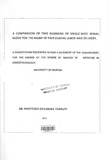| dc.description.abstract | Backaround/lntroduction:
Most women experience moderate to severe pain during labor and delivery, often requiring some form of pharmacologic analgesia. The lack of proper psychological preparation combined with fear and anxiety can greatly enhance the patient's sensitivity to pain and further add to the discomfort during labor and delivery. However, skillfully conducted obstetric analgesia, in addition to relieving pain and anxiety, may benefit the mother in many other ways. The old perception of 'the true African woman' was of one able to withstand labor pain and deliver spontaneously. Those who for one reason or another ended up delivering through caesarian section were looked down upon. Over time, the perception- of labor pain has been influenced by many factors and most women in Africa will now opt for pain relief during labor if it is available. Non-pharmacologic analgesic techniques and systemic analgesia can be used for the relief of pain during labor. However, neuraxial analgesia, particularly epidural techniques, are the most effective methods available todav'.
Objective:
To assess and compare the satisfaction and efficacy of two regimens of single-shot spinal blocks for the relief of labor pain in women who present in active labor.
Design:
This was a prospective randomized single-blind interventional study in which two regimens of spinal analgesia for labor were used at The Kenyatta National Hospital in Kenya.
Research Methodoloav:
All consenting primiparous women presenting in active labor with uncomplicated singleton pregnancy at term (> 36 weeks) in the vertex position who report a > 70 mm VAS (Visual Analog Scale) pain score at cervical dilatation ~ 5 cm at the time of request for labor analgesia were recruited into the study. 48 patients were included in each of the two groups. We hypothesized that spinal analgesia with the addition of preservative-free. morphine to a solution with bupivacaine and fentanyl would prolong analgesic effect over that of bupivacaine/fentanyl alone and that this technique would provide an effective means of pain relief during labor. Data was collected on a pretested data sheet and analyzed using Statistical Package for Social Scientists (SPSS) software version 16.0. The results were presented in the form of tables, graphs and charts.
Results
The single shot spinal analgesia was performed in 105 parturients, 57 in FB and 48 in FBM groups. Threeparturients from the FB group were excluded because they underwent caesarian section due to obstetric indications after successful single shot spinal analgesia while 6 others were left out after randomization.
Demographic maternal baseline data didn't show a significant statistical difference between the two groups. Though we had a significant statistical p-Vatue for the cervical dilation at the initiation of the injection, this didn't have any clinical Significance during the progress of labour and outcome of the fetus. Parturients from the FB group had pain relief for about 2 hours with higher incidence of breakthrough pain, while in the FBM group pain relief was for more than 3 hours (until delivering time). Hence we had 81.2% in FBM group very satisfied against 31.3% in FB group, this can be explained by the short duration of analgesia among the FB parturients. The rate of complication was higher in FBM but was all mild and no medication was required, only hypotensive parturients received boluses of ephedrine. At the time of delivery, the Apgar score at 1 minute was lower in FBM group but at 5 minutes there was no significant difference
between the two groups. | en_US |

